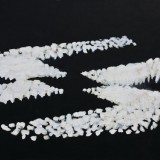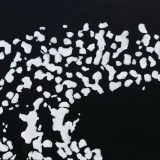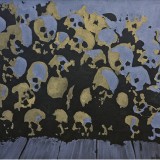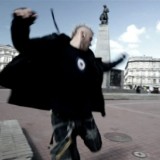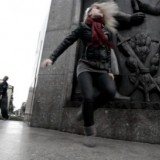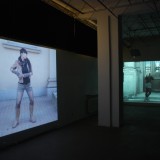Ewa Bloom Kwiatkowska
When the crematoria of art smoke, when the chimneys of religion burn1
In 1989 an artist Ewa Bloom-Kwiatkowska from £ód¼ burned her works as a protest. The action which was described by the artist as a combustation, which is a ritual burning, took place in an open public area of £ód¼. The event was accompanied by an apocalyptic manifesto by S³awomir Kosmynka2
This date became a borderline not only in the art of Ewa Bloom-Kwiatkowska, but also marking a time of a political breakthrough. Five months later in Poland the first free elections took place which caused radical changes in all aspects of life, including art. Of course the changes would be difficult to predict for artists active then in the L-Und – underground £ód¼ art scene, to which Bloom-Kwiatkowska and Kosmynka belonged amongst others.
Why did Ewa burn her works? The cases of artists destroying their own artworks in many ways and for many reasons are not isolated cases in art history, but they are rather rare. Another action which meaningfully close to Ewa’s gesture happened later – in 2013, when 35 Turkish artists burned their works to commemorate the 20th anniversary of a massacre in Sivas, where as a result of an attack by Islamic fundamentalists on a hotel, 35 people died, including 33 Turkish intellectuals. The destroyed works were later exhibited. Ewa Bloom-Kwiatkowska’s decision to totally annihilate her own artworks, which are her artistic „ego”, may be compared to the gesture of people who decide to ignite themselves to express their protest against totalitarianism, violence and the hopelessness of human existence in such a reality. The attack on her own art was at the same time her most radical artistic gesture. Ewa burned both her paintings and painted objects which were created in a spirit of expressionism and which featured the topic of criminal totalitarian ideas. She burned the series of paintings entitled They and objects – gates entitled The Power of Will, Transition, and The Dream of an Architect. Hommage a Albert Speer.
The artist graduated from the Department Textiles and Clothing in the Academy of Fine Arts in £ód¼ in in 1986. Her diploma work was awarded with a bursary from the Ministry of Culture. Her participation in the exhibition 50 Kleider? in Monhengladbach in 1984, featuring also Andy Warhol, Denis Oppenheim, Allan Jones and Italo Scango was a very important event in her artistic career. Ewa Kwiatkowska was the youngest among the artists presenting works during that exhibition. She showed works devised during her studies – coats with the motive of machine guns, dresses with prints showing bomb explosions and a series of large format graphics completed in a silk-screen printing studio. She participated in the exhibition thanks to a visit in the Academy of Fine Arts by the art critic Szymon Bojko, who considered Ewa’s works worth recommending to the curator Erica Hoffman. Ewa could not go to the exhibition herself, as she did not receive a passport because of her involvement with the political opposition.
After burning her works in 1989 Ewa Bloom-Kwiatkowska distanced herself from the art world for a few years and started to design costumes and set design. Since that time, she has designed sets for over 50 theatre plays and TV productions including: Republic – public matter, Maria and Woyzeck, Crime and Punishment, Paradise Gate, Short at the meeting point, A Suicide, Faust goes rock and Winter tale and she has co-operated with Adam Hanuszkiewicz, Ewa Wycichowska, Pawe³ Nowicki and Grzegorz Kźpiński among others. She is a laureate of many awards and distinctions, for example the Stanis³aw Wyspiański Award for Young Artists of theatre set design. Her paintings, drawings, painting-sculpture arrangements and design sets were shown during numerous exhibitions and individual events in Poland, France, Germany, USA and Great Britain. She currently also runs the Studio of Theatre and Film Costume at the Academy of Fine Arts in £ód¼.
In 2005 she returned to painting and has also since then created installations and video art works. The series of paintings Ideas and Masks and The Book of Chronicles XX refer to the themes of genocide and violence and images of them in mass media transmission. Ewa Bloom-Kwiatkowska paints images taken from TV screen shots and also makes a synthesis, reducing the image to the role of a sign, often an almost abstract one. By the reduction of detail she strengthens the message. In paintings entitled Lights V from the Book of Chronicles we see many white dots against black background and in one of the paintings the dots are formed into a swastika. The viewer’s imagination suggests the rest of the interpretation. The Book of Chronicles XX is a reference to the title of books from the Old Testament (Book of Chronicles I and II). The artist recalls an analogy between the times of violence when the first Jewish kings were in power and the crimes and cruelty of the wars in the 20th century, whose consequences we still feel even now. At the same time she reminds us, that totalitarian systems still exist, human rights are still violated. On paintings entitled Boys we recognise figures of Asians in gala costumes (North Korea?), running soldiers (Afghanistan?, Iraq?) or a dark silhouette drawn against the background of a window – in a painting entitled Prisoner. In the series Ideas and Masks we can also see references to the history of art: among others to the sculpture of Katarzyna Kobro – white geometric forms – one of them Bloom-Kwiatkowska shows against the background of a black trickling image on white canvas. Is the artist asking a question through her painting about the possibilities for art when confronted by totalitarianism and terror?
In her video work Circle; who has imaginary phobias but deserves real ones instead? (2009) the artist uses a found-footage technique. The video is based on fragments of a Japanese horror movie Ring. The artist appears herself in the scenes from the movie as its main heroine. The work as a whole gives the impression of a nightmare and an imaginary reality. But one may ask a question what will happen when our minds stops noticing the difference between the imaginary image and the real image? In the film Colour is burning from 2010 after 23 years she returned to the action Smoke above the City [Der Himmel uber Stadt] in which she burned her works. The video consists of archival photos of her painting-sculpture objects and photos showing the moment of burning them. The image is accompanied by sound and music.
In 2011 as part of the Art and Documentation Festival she showed a video installation on several monitors entitled St. Vito’s Dance which was at the same time a documentation of a performance which had taken place at Wolno¶ci Square in £ód¼ a year earlier. The artist referred in it to the medieval “dance epidemic” during which, for reasons unexplained even today, in a dance parades which lasted a few days, inhabitants over the whole of Europe participated, regardless of their class, origin and nation. They were captivated by the impulse to dance against their will and this led to extreme exhaustion. It was inexplicable and frenzied, but after the finale, the dancers were cleansed from worries, fears and anger. It did not spare anyone but connected all.
Ewa Bloom-Kwiatkowska returned to art with a fresh perspective and new ideas. She is still concerned with the topic of violence and the dark spheres within the human psyche, but speaks about them using a different visual language and new means of expression.
1. A quotation from S³awomir Kosmynka’s manifesto entitled “The War of Images” read during the action Smoke above the City.
2. Xawery Stańczyk, http://www.tabu-trend-transgresja.pl/content/xstanczyk.pdf.
Anka Le¶niak


